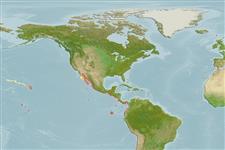>
Eupercaria/misc (Various families in series Eupercaria) >
Haemulidae (Grunts) > Haemulinae
Etymology: Haemulon: Greek, haimaleos = bloody (Ref. 45335).
More on author: Gill.
Environment: milieu / climate zone / depth range / distribution range
Ekologi
laut dasar (demersal). Tropical; 38°N - 1°S
Eastern Pacific: Mexico to Ecuador.
Size / Weight / umur
Maturity: Lm ? range ? - ? cm
Max length : 42.0 cm TL jantan/; (Ref. 9114); common length : 35.0 cm TL jantan/; (Ref. 9114)
Body oblong, compressed, and fairly deep (depth contained 3.0 to 3.1 times in standard length); mouth large, terminal, and oblique, its anterior edge located at the same level as the center of the eye; first gill arch with 26 to 36 gill rakers; dorsal fin notched, with 10 to 12 spines and 15 to 18 soft rays (X-XII, 15-18); second anal spine longer and stronger than third; scale series above lateral line oblique; body light brown; each scale bearing a pearly blue spot, the spots appearing to form lines following the scale series; fins yellowish (Ref. 55763).
Benthic in coastal waters. Forms schools over rocky and sandy bottoms. Feeds at night. Marketed fresh.
Oviparous, distinct pairing during breeding (Ref. 205).
McKay, R.J. and M. Schneider, 1995. Haemulidae. Burros, corocoros, chulas, gallinazos, roncos. p. 1136-1173. In W. Fischer, F. Krupp, W. Schneider, C. Sommer, K.E. Carpenter and V. Niem (eds.) Guia FAO para Identification de Especies para lo Fines de la Pesca. Pacifico Centro-Oriental. 3 Vols. FAO, Rome. (Ref. 9114)
Status IUCN Red List (Ref. 130435)
ancaman kepada manusia
Harmless
penggunaan manusia
Perikanan: nilai komersial kecil
informasi lanjut
AcuanBudidaya airprofil budidaya airStrainGenetikaElectrophoresesDiturunkanPenyakit-penyakitPengolahanNutrientsMass conversion
mitraGambarStamps, Coins Misc.Suara-suaraCiguateraKecepatanTipe renangArea insangOtolithsOtakPenglihatan / visi
Alat, peralatan
laporan khas
muat turun XML
Sumber internet
Estimates based on models
Preferred temperature (Ref.
123201): 20.6 - 28.5, mean 25.8 °C (based on 56 cells).
Phylogenetic diversity index (Ref.
82804): PD
50 = 0.5000 [Uniqueness, from 0.5 = low to 2.0 = high].
Bayesian length-weight: a=0.01549 (0.00681 - 0.03521), b=3.02 (2.84 - 3.20), in cm total length, based on LWR estimates for this Genus-body shape (Ref.
93245).
Trophic level (Ref.
69278): 4.2 ±0.73 se; based on food items.
Generation time: 9.6 ( na - na) years. Estimated as median ln(3)/K based on 1
growth studies.
Daya lenting (Ref.
120179): Rendah, Waktu penggandaan populasi minimum 4.5 - 14 tahun (K=0.12).
Fishing Vulnerability (Ref.
59153): High vulnerability (58 of 100).
Nutrients (Ref.
124155): Calcium = 88.6 [26.8, 228.3] mg/100g; Iron = 0.978 [0.480, 2.078] mg/100g; Protein = 18 [16, 20] %; Omega3 = 0.164 [0.075, 0.330] g/100g; Selenium = 47.1 [18.8, 107.3] μg/100g; VitaminA = 32.3 [8.3, 127.5] μg/100g; Zinc = 0.894 [0.552, 1.381] mg/100g (wet weight);
